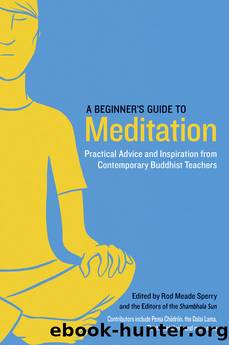A Beginner's Guide to Meditation by Rod Meade Sperry

Author:Rod Meade Sperry
Language: eng
Format: epub
Publisher: Shambhala
Going Nowhere
Lewis Richmond
The Zen practice of shikantaza, just sitting, says Lewis Richmond, doesnât help us to reach our destination. It allows us to stop having one. But how do you âgoâ nowhere?
THE PRACTICE OF âjust-awarenessâ is the essence of Zen meditation. The Japanese word for this, shikantaza, is usually translated as âjust sitting,â but Dogen, the founder of the Soto school of Zen, specifically taught that zazen is âbeyond sitting or lying down.â Shikantaza is more than the mere physical posture of sitting, although it certainly includes that. Fundamentally it is the practice of just being here, being presentâexcept that we are not rocks or stones, but aware beingsâso I think âjust-awarenessâ more fully captures the essence of the term. But awareness of what? That is the first question.
Most people new to zazen think that itâs a skill that can be learned, like tai chi. We come to zazen instruction and are told to sit a certain way, hold the hands just so, keep the eyes open, and pay attention to the breath. It seems rather easy; we look forward to becoming more accomplished in it. But Dogen admonishes us, âZazen is not learning to do concentration.â He seems to be implying that our ambitions to improve are not quite on the mark.
We can be forgiven for thinking that if we do the same thing over and over, we will improve. But is âjust being hereâ a skill to be learned? Do we ever get better at that? I donât think so. From the first moment of life to the last, weâre always just here. Our pure awareness doesnât develop, doesnât change, doesnât grow up, and doesnât grow old. I was recently talking to a 105-year-old woman, and she said, âWell, I donât feel 105. Itâs just me.â She felt the same as she did when she was a young girl. So, from that point of view, none of us exactly grows old. Something grows oldâthe body perhaps, or our memoriesâbut does our âbeing hereâ grow old? No. How could it?
This gives us a clue to the kind of practice weâre talking about. Itâs not some kind of yogic concentration practice, such as Gautama Buddha himself practiced early in his spiritual career. When he was young, Gautama went around to various yoga teachers and learned how to develop trance states and psychic powers. He became very accomplished at these; he âimproved.â But in the end he felt that all these practices missed the fundamental point. No matter how good we get at something, eventually we grow old, become sick, and die; all our powers come to naught. Gautamaâs conclusion was that all of these concentration practices really didnât work, because in the end theyâre just states of consciousness to go into and come out of; they donât really address the ground of being or the cause of human suffering.
Leaving all those practices behind, Gautama recalled a time when, as a child, he sat under a tree and spontaneously felt ease and joy.
Download
This site does not store any files on its server. We only index and link to content provided by other sites. Please contact the content providers to delete copyright contents if any and email us, we'll remove relevant links or contents immediately.
The Practice of Classical Palmistry by Madame la Roux(398)
How to Be Your Own Therapist by Owen O'Kane(376)
Predicting Your Future through Astrology by Sita Ram Singh(371)
2021 Quantum Human Design Evolution Guide by Karen Curry Parker(296)
Yoga for Beginners: Your Natural Way to Strengthen Your Body, Calming Your Mind and Be in The Moment (Yoga Poses) (A Better You Book 1) by Susan Mori(281)
Magic of Isis: A Powerful Book of Incantations and Prayers by Alana Fairchild(270)
Writing Guide for Memorandum of Understanding by unknow(247)
Christmas Witch (Hot Hex 3) by Susan Stephens(245)
Africa's Diabolical Entrapment: Exploring the Negative Impact of Christianity, Superstition and Witchcraft on Psychological, Structural and Scientific Growth in Black Africa! by Larr Frisky(239)
Tarot de Marseille by Marius Høgnesen & Paul Marteau(237)
Learn Cold Reading: The real secret of mind readers by Reynolds Ethan(234)
The Enfield Poltergeist Tapes: One of the most disturbing cases in history. What really happened? by Melvyn J. Willin(232)
Shadow Worlds by Andrew Wood(232)
Design Guide to Learn Calligraphy: Fonts, Styles, Pens, Letters, & Numbers by Agatha Adams(224)
The Stuff of Dreams by Edward Lucas White(220)
Miracle Minded Manager by John Murphy(214)
The Watkins Tarot Handbook by Naomi Ozaniek(209)
Witch: A Magickal Journey by Fiona Horne(196)
The World's Most Mysterious Objects by Patricia Fanthorpe & Patricia Fanthorpe(196)
